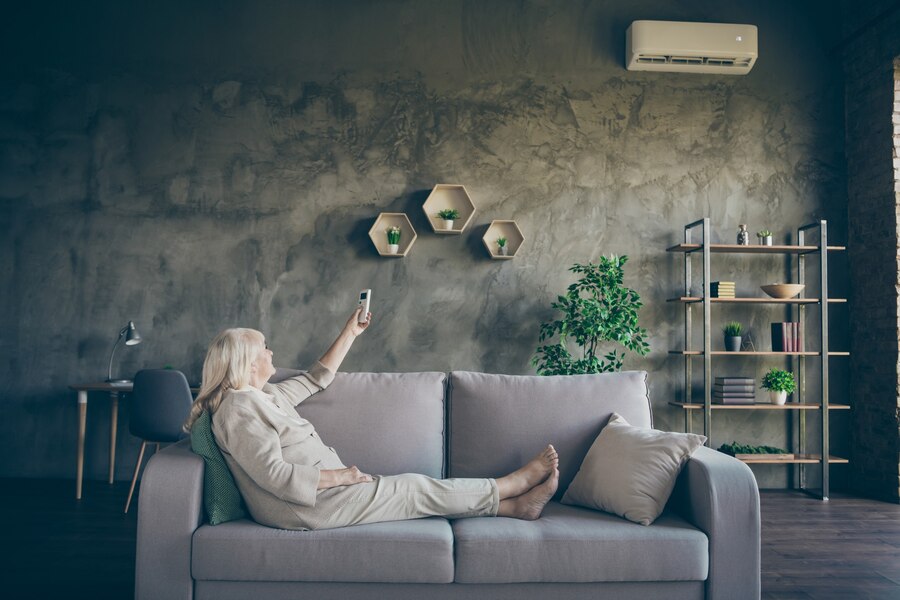
As temperatures rise, keeping your home cool becomes a top priority for comfort and well-being. However, the thought of high energy bills can leave homeowners sweating over the cost of maintaining a comfortable indoor environment. Fear not! With a few savvy strategies and practical tips, you can keep your home cool without breaking the bank. Join us as we explore expert advice for mastering home cooling while keeping costs in check. With the expertise of Tradewind Heating and Air, homeowners in Orange, California can rely on efficient cooling solutions to stay comfortable all summer long without worrying about skyrocketing energy bills.
Heating and Air Conditioning Services
Use Ceiling Fans to Circulate Air Efficiently
Ceiling fans are a simple yet effective way to circulate air and maintain a comfortable temperature in your home. During warmer months, set your ceiling fans to rotate counterclockwise to create a cooling breeze. This helps distribute cool air more evenly throughout the room, allowing you to reduce reliance on your air conditioning system and save on energy costs.
Additionally, using ceiling fans in conjunction with your air conditioner allows you to raise the thermostat temperature by a few degrees without sacrificing comfort. This minor adjustment can lead to significant energy savings over time while keeping your home cool and comfortable.
Close Blinds or Curtains During the Hottest Parts of the Day
Direct sunlight streaming through windows can quickly heat up your home, forcing your air conditioner to work harder to maintain a comfortable temperature. To combat this, close blinds or curtains during the hottest parts of the day to block out sunlight and reduce heat gain.
Opt for light-colored or reflective window treatments that deflect sunlight and heat, helping to keep indoor temperatures cooler. Additionally, consider investing in blackout curtains or shades for rooms that receive direct sunlight, as these provide additional insulation and help prevent heat transfer.
Seal Gaps Around Windows and Doors to Prevent Air Leaks
Air leaks around windows and doors can allow cool air to escape from your home while allowing hot air to infiltrate, leading to energy waste and increased cooling costs. To prevent air leaks, inspect windows and doors for gaps or cracks and seal them with weatherstripping or caulking.
Focus on areas where drafts are most likely to occur, such as around window frames, door jambs, and attic hatches. By sealing these gaps, you can improve energy efficiency, reduce air conditioning costs, and create a more comfortable indoor environment for you and your family.

Optimize Thermostat Settings for Energy Savings
Setting your thermostat to the optimal temperature can help you maintain a comfortable indoor environment while maximizing energy savings. During the summer months, aim to set your thermostat to the highest temperature that is still comfortable for you and your family.
The U.S. Department of Energy recommends setting your thermostat to 78°F when you’re at home and raising it by a few degrees when you’re away or asleep to save energy. Investing in a programmable or smart thermostat allows you to automate temperature adjustments based on your schedule, further optimizing energy savings without sacrificing comfort.
Consider Investing in Energy-Efficient Appliances and Insulation
Upgrading to energy-efficient appliances and improving insulation can significantly reduce your home’s cooling costs while enhancing comfort and energy efficiency. Consider replacing older, inefficient air conditioning units with ENERGY STAR® certified models that are designed to consume less energy and operate more efficiently.
Additionally, investing in attic insulation, sealing ductwork, and upgrading to high-efficiency windows can help prevent heat gain and loss, reducing the workload on your air conditioning system and lowering cooling costs. While these upgrades may require an initial investment, the long-term energy savings and improved comfort make them a worthwhile investment for homeowners.
Cooling Your Home Without Breaking the Bank
In conclusion, keeping your home cool doesn’t have to come at a high cost. By implementing these practical tips and strategies, you can effectively manage indoor temperatures while minimizing energy expenses. From using ceiling fans to circulate air efficiently and closing blinds or curtains to seal out sunlight, to sealing gaps around windows and doors and optimizing thermostat settings for energy savings, there are plenty of budget-friendly ways to keep your home cool and comfortable.
At Tradewind Heating and Air, we understand the importance of energy efficiency and cost-effective cooling solutions for homeowners. If you’re looking to optimize your home’s cooling system or explore energy-efficient upgrades, our team of HVAC experts is here to help. Contact us today to schedule a consultation and discover how you can keep your home cool without breaking the bank.

FAQs
- How can ceiling fans help keep my home cool while saving on energy costs?
- Ceiling fans can circulate air effectively, allowing you to reduce reliance on your air conditioning system and save on energy costs. Setting them to rotate counterclockwise during warmer months creates a cooling breeze, distributing cool air evenly throughout the room.
- What are the benefits of closing blinds or curtains during the hottest parts of the day?
- Closing blinds or curtains blocks out direct sunlight, reducing heat gain in your home and alleviating the workload on your air conditioner. Opting for light-colored or reflective window treatments can further deflect sunlight and keep indoor temperatures cooler.
- How can I identify and seal gaps around windows and doors to prevent air leaks?
- Inspecting windows and doors for gaps or cracks and sealing them with weatherstripping or caulking helps prevent air leaks. Focus on areas prone to drafts, such as window frames, door jambs, and attic hatches, to improve energy efficiency and reduce cooling costs.
- What are the recommended thermostat settings for optimal energy savings during the summer?
- The U.S. Department of Energy recommends setting your thermostat to 78°F when you’re at home and raising it by a few degrees when you’re away or asleep to save energy. Programmable or smart thermostats allow you to automate temperature adjustments based on your schedule, maximizing energy savings.
- How can upgrading to energy-efficient appliances and improving insulation reduce cooling costs?
- Upgrading to ENERGY STAR® certified air conditioning units and improving insulation can reduce heat gain and loss, lowering the workload on your cooling system and decreasing cooling costs. These upgrades enhance energy efficiency and comfort, making them a worthwhile investment for homeowners.
- Why is it important to consider energy efficiency and cost-effective cooling solutions for homeowners?
- Energy-efficient cooling solutions help minimize energy expenses while maintaining indoor comfort, making them essential for budget-conscious homeowners. Optimizing cooling systems and implementing energy-saving strategies contribute to long-term savings and environmental sustainability.
- What role does Tradewind Heating and Air play in helping homeowners optimize their cooling systems?
- Tradewind Heating and Air provides expertise in optimizing home cooling systems and offers energy-efficient solutions to help homeowners manage indoor temperatures effectively while minimizing cooling costs. Their team of HVAC experts is available to provide consultations and guidance on cost-effective cooling solutions.
- Are there additional steps homeowners can take to keep their homes cool without breaking the bank?
- Yes, homeowners can also consider alternative cooling methods such as using portable fans, implementing shading solutions for outdoor spaces, and reducing heat-generating activities indoors to further enhance cooling efficiency and save on energy costs.
- How can I determine if my home would benefit from energy-efficient upgrades to improve cooling efficiency?
- A home energy audit conducted by HVAC professionals can assess your home’s energy usage and identify areas for improvement. This evaluation helps determine the most cost-effective upgrades to optimize cooling efficiency and reduce energy expenses.
-
What resources are available for homeowners interested in learning more about energy-efficient cooling solutions?
- Homeowners can reach out to HVAC companies like Tradewind Heating and Air for consultations and educational resources on energy-efficient cooling solutions tailored to their specific needs and budgetary considerations. Additionally, online resources and government programs provide information on energy-saving initiatives and incentives for homeowners.
